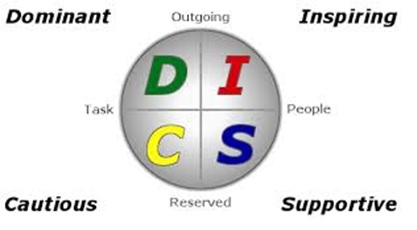
If you’re a high S, here’s how you relate…
…to a high D:
People with the D style like to get right to the point. They’re willing to be straightforward and even blunt at times in the interest of making rapid process. You’re more likely to be tactful and soft-spoken, so they may dominate discussions with you. While they may not see this as a problem, you probably feel somewhat intimidated by them. At the same time, they may become frustrated by your unwillingness to speak up.
Strategies:
- When trying to connect, avoid appearing too hesitant and indecisive.
- Remember that they appreciate a direct approach, so don’t be afraid to tell them what you’re thinking.
- Be prepared for their candor.
- When solving problems, avoid appearing hesitant or indecisive.
- Be willing to take a stronger stance.
- Speak up to make sure you have a voice in the solution.
- If things get tense, avoid giving in to their demands just to regain harmony.
- Know that hiding your true feelings could be more harmful than speaking candidly.
- Be aware that they will reciprocate when you challenge them, and they may be more aggressive.
…to an I style:
People with the Ii’ style are extremely outgoing and share your priority on working collaboratively. But even though you both working as a team, they’re probably a bit more adventurous and sociable than you are. At times, they may push you to open up more than is comfortable for you, and if you hold back, they may see you as too restrained.
- When trying to connect, speak up when you’re concerned about how plans affect other people.
- Show them that you value your working relationship by maximizing opportunities to work collaborate together.
- Recognize the value of their enthusiasm and high energy.
- When solving problems, show them that you’re open to creative solutions.
- Share your doubts rather than just going along with their ideas to make them happy.
- Balance your desire for stability with the opportunities provided by their adventurous approach.
- When things get tense, refrain from burying your own feelings just to regain harmony.
- Address the issues directly but empathically.
- Let them know that a disagreement now doesn’t mean a poor relationship down the road.
…with another S style:
People with S style value cooperation and friendly interaction. Like them, you prioritize collaboration and getting everyone involved. However, the two of you might be so considerate that neither of you speaks up about your own needs. In addition, you both probably prefer an easygoing, gentle approach and, as a result, you may fail to push yourselves to ask tough questions when working together.
- When trying to connect, share what you’re really thinking and let them know that you genuinely want to hear their opinions.
- Encourage each other to move outside your comfort zones and take on new challenges.
- Work collaboratively with them, but don’t overlook potential problems.
- When problems need to be solved, establish a deadline to avoid delaying decisions, and find ways to make minor decisions more quickly together.
- Consider risks, but remember that sometimes a daring idea can bring more satisfying results.
- Don’t’ let your shared reluctance to rock the boat keep you from considering more creative options.
- When things get tense, address the situation directly right from the start rather than masking your differences.
- Express your concern for their feelings and show a desire to work through the conflict quickly but thoroughly.
- Be aware that holding in your feelings could be more harmful than speaking candidly.
…with a C:
People with the C style would rather focus on facts than feelings. They tend to focus on precision, so they probably appreciate your calm, methodical approach. However, since they tend to be skeptical and analytical, they may see your trusting, supportive nature as naïve, while you may find their down-to-business attitude a little cold.
- When trying to connect, focus on the fact-based aspects of ideas and projects.
- Don’t be put off by their reserved, sometimes skeptical approach.
- Respect their preference to work independently.
- When problems need to be solved, set a timeline for finding a solution and balance your shared caution with the need for urgency.
- Avoid getting bogged down trying to find the perfect plan that meets everyone’s needs.
- Join them in careful analysis, but remember to keep an eye on the timeline.
- When things get tense, be more assertive about your needs, because they may not realize when your feelings have been hurt.
- Give yourselves time to process, but don’t allow the situation to linger indefinitely.
- Use your shared tendency to challenge ideas to keep conflict visible so you can work toward resolution.
Prompts/Pre-frames to use with a High S personality style:
Suggestion: As a High S, learn how to “bubble up”. Take a moment before interacting with a strong D or I, to take a deep breath, center yourself and prepare yourself for their external personality style. Remain neutral, focus on the facts and intention, not the feelings. Try not to get defensive. Once you become defensive, the conversation stops.
“I appreciate your candor, however, sometimes our conversations feel aggressive, how can I share that with you when that occurs?”
“I am sometimes emotional, please don’t take that personally, every now and then, I need a moment to re-center.”
“People are my highest priority, sometimes it feels like you don’t care about people, help me to understand your perception/priority.”
“I know that people are you highest priority, however, we also have this goal to achieve, how can we meet that goal and take care of the people at the same time?”
“I can see that you are emotional, how about we take a few minutes and reconvene when we are both in a better place.”
“I know you are excited about this, can we slow down just a bit, so I can take it all in and process?”
“I appreciate the stability you bring to our organization and I know I get excited and move fast sometimes, help me by advocating for the stability we need to keep our business running.”


